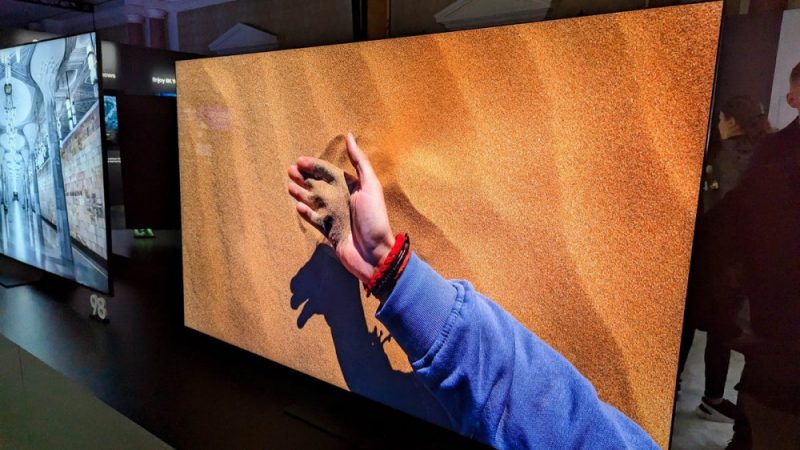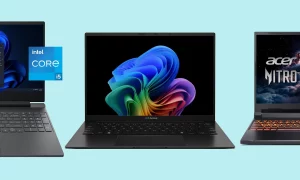Should You Use an OLED TV as a Computer Monitor?


Even the most casual PC gamer is always looking for ways to improve their setup. But one method, which has gained a lot of popularity, is a bit questionable—some people are pairing their PCs with OLED TVs.
There are several benefits to using an OLED TV as a computer monitor. However, there are also plenty of downsides. If you have the space and the resources, you’re usually better off using an OLED TV as a secondary monitor. That way, you get the best of both worlds.
Why Use an OLED TV as a Monitor?
The Problem: OLED Burn-in
The Solution: Use Your OLED TV as a Secondary Monitor
How Long Will an OLED TV Last as a Computer Monitor?
Should You Use an OLED TV as a Computer Monitor?
Why Use an OLED TV as a Monitor?
Most TVs and computer monitors utilize an LCD panel. And, for the most part, LCD panels are perfectly acceptable—they’re bright, crisp, and affordable. There’s just one big problem; LCD technology requires a backlight, which makes it impossible to achieve a true-to-life contrast ratio.
In other words, if you put a totally black image on an LCD display, it will look gray. But an OLED panel doesn’t suffer from this problem. With OLED, each pixel on the screen makes it own light and can turn itself on and off. There’s no backlight. Not only does black look truly black, but all colors appear to be more accurate and vibrant.
And because OLED pixels are independently controlled, OLED screens tend to have a speedy response time. This is where PC gamers start to perk their ears—with its deep contrast, accurate colors, and zippy response time, OLED appears to be the perfect solution for gaming.
But when OLED TVs started gaining traction, OLED computer monitors were somewhat rare. They were also quite expensive, and really, most models were intended for visual artists. Gamers decided to employ the classic, time-honored tradition of simply using a TV as their computer monitor. (And YouTubers accelerated the trend by throwing giant 75-inch OLED TVs on their desks.)
We’ve reached the point where OLED gaming monitors are somewhat common. But an OLED TV still gives you more bang for your buck. Here’s a quick example; would you rather spend $1,000 on a 27-inch LG OLED 1440p monitor, or on a 55-inch LG OLED 4K TV? They’re the same price, but the TV is clearly a much more cost-effective option.
The math makes sense, so gamers continue to use OLED TVs as computer monitors. And this trick comes with a couple of extra benefits—TVs tend to offer better HDR support than most monitors, they’re often the best choice for console gaming, and your OLED TV “monitor” can double as a real TV.
The Problem: OLED Burn-in

Pairing an OLED TV with your computer might be a smart idea. But there’s one big problem—all OLED screens suffer from burn-in. This effect is impossible to avoid, and unfortunately, burn-in tends to happen much more quickly when an OLED screen is forced to display a computer’s desktop.
Let’s step back for a moment. The pixels in an OLED screen contain organic matter. When a voltage is applied to this matter, it illuminates. But it also degrades a bit. As you put stress on these pixels, they slowly get dimmer and dimmer.
And, unfortunately, this dimming effect is tied to individual pixels. If you constantly watch the news on an OLED TV, for example, then the bottom of the screen (which is usually lit up by a chyron) will wear out at an increased rate. Eventually, after several years of use, the news chyron will appear to be “burnt into” your TV.
This isn’t such a big deal for TV viewers, who tend to cycle through a lot of content. But it’s terrible for computer users. Most of the stuff on your computer screen is static—it doesn’t move. Just think of the Windows Taskbar, or your wallpaper, or the icons at the top of your browser. These portions of your operating system will accelerate the burn-in effect on an OLED TV.
I should clarify that OLED computer monitors are just as vulnerable to burn-in as OLED TVs. But they use aggressive power-saving and “pixel refresh” technology to try and avoid this problem. In my experience, OLED computer monitors can be extremely annoying, as these preventative steps waste a lot of time and can interrupt whatever you’re doing.
The Solution: Use Your OLED TV as a Secondary Monitor

Here’s the good news; if you use an OLED TV exclusively for gaming or watching videos, you don’t need to worry too much about burn-in. And this idea is very easy to implement. Simply use an OLED TV as a secondary monitor!
This way, you get the best of both worlds. You can use a normal computer monitor for basic tasks, and when it’s time to play games or watch videos, just fire up the TV. Let’s be honest—a giant TV isn’t great for browsing the web anyway, and modern computer monitors pack a ton of great features, such as integrated USB hubs.
Plus, most computers lack HDMI-CEC support, meaning that they cannot control a TV’s power or volume status. When using a TV as a primary monitor, the lack of HDMI-CEC is kind of a pain in the neck. But it’s actually a nice perk when a TV is your secondary monitor—the TV only turns on when you want it to, and its volume can be independent from that of your computer.
All you need to do is hook up your computer monitor and TV to your PC. Then, navigate to your display settings and set up the TV as a secondary monitor (you may need to make some adjustments to resolution and such).
If your computer only has one video port, you’ll need a USB to HDMI adapter for your TV. Or, try using a docking station, which gives you a bunch of additional USB ports and an Ethernet jack, which may be useful when gaming.
How Long Will an OLED TV Last as a Computer Monitor?

With all this doom and gloom, it may seem like OLED TVs are just a terrible investment. But that’s not the case at all. If you just use an OLED TV to play games or stream video, there’s no reason why it shouldn’t last a full decade. The picture will slowly get dimmer, but it’ll be usable for a long time.
Manufacturers like LG claim that their OLED TVs will endure 100,000 hours of normal activity—watching shows and movies, playing games, and so on. This estimate is probably a bit too generous. But even if we take a very conservative estimate of 30,000 hours, an OLED TV should last a long time under normal use. A 30,000-hour lifespan is equivalent to watching 8 hours of TV every day for 10 years!
But what happens if you really abuse an OLED TV? According to the U.S. Department of Energy Efficiency, an OLED TV that’s kept at maximum brightness 24/7 will last about 3.5 years beore its picture is unwatchable. In this case, “unwatchable” means “the TV is 70% dimmer than when you bought it.”
Based on this data, we can estimate that an OLED TV used for normal computer tasks (browsing, writing, etc) will need to be replaced after three to five years. Clearly, using the OLED TV as a secondary gaming or video monitor is a much smarter option.
Should You Use an OLED TV as a Computer Monitor?

An OLED TV will last a long time if it’s used for “normal TV stuff,” such as playing games or watching videos. Using an OLED TV as a regular computer monitor will seriously reduce its lifespan, as the non-moving elements on your computer’s desktop can accelerate burn-in.
Your best option is to use an OLED TV as a secondary monitor. When it’s time to play a game, watch a movie, or binge some Netflix, turn on the OLED TV and enjoy its awesome quality. Web browsing and other tasks can be relegated to a normal, reasonably-sized computer monitor.
As for whether this is a good idea—sorry, that’s your decision. In some situations, buying an OLED TV exclusively for PC gaming is probably overkill. But maybe you keep your PC in the bedroom or living room; these rooms probably need a TV anyway, so it couldn’t hurt to buy a TV that doubles as a PC gaming monitor.










